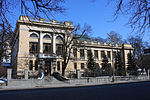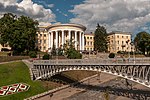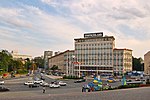Rylsky Institute of Art Studies, Folklore and Ethnology
Research institutes in Ukraine

The Rylsky Institute of Art Studies, Folklore and Ethnology (IAFE; Ukrainian: Інститут мистецтвознавства, фольклористики та етнології ім. М. Т. Рильського, Instytut mystetsvoznavstva, folklorystyky ta etnolohiyi imeni M. T. Ryl’s’koho) is a research institute in Kyiv, Ukraine, established in August 1936.
Excerpt from the Wikipedia article Rylsky Institute of Art Studies, Folklore and Ethnology (License: CC BY-SA 3.0, Authors, Images).Rylsky Institute of Art Studies, Folklore and Ethnology
Mykhaila Hrushevskoho Street, Kyiv Клов
Geographical coordinates (GPS) Address Nearby Places Show on map
Geographical coordinates (GPS)
| Latitude | Longitude |
|---|---|
| N 50.4509 ° | E 30.5286 ° |
Address
Mykhaila Hrushevskoho Street 4
01008 Kyiv, Клов
Ukraine
Open on Google Maps







